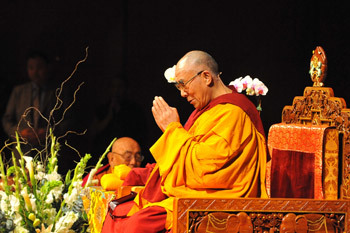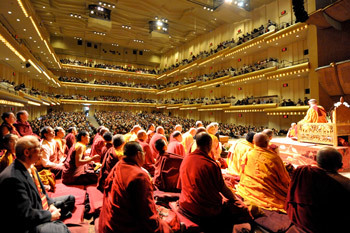The interview over, His Holiness joined a meeting of the Mind & Life Institute board and their supporters and friends. The Institute is twenty-five years old and looking to map the direction it will take over the next twenty-five years. Suggestions derived from discussions in small groups were brought to His Holiness’s attention.
His Holiness was pleased to see that two Japanese had joined the meeting, because Japan is a traditionally Buddhist country where he has been meeting people for many years. More recently these meetings have also included scientists. He also extended his greetings to representatives from Mongolia.
Regarding his own engagement with science he said,
“For the last 30 years we Tibetan Buddhists have been in contact with modern scientists. This began as a personal interest of mine, but when it became clear that there was a more universal purpose to be served we began to involve others. I’m happy to tell you that we now have monks and nuns who have studied science with Emory University in Atlanta. Scientific textbooks have been prepared in Tibetan. And, most important, science has been formally incorporated into our monastic training curriculum.”
Teaching for Mongolians and Tibetans
In the early afternoon, His Holiness drove to the Lincoln Center where he had been invited to teach by the Mongolian and Tibetan Communities of New Jersey and New York. The 2700 seat auditorium was filled to capacity and many more eager listeners were gathered outside the Center in the bright autumn sun. His Holiness asked for facilities to be made available for them to hear what he had to say before he went in to greet the audience.

|
His Holiness the Dalai Lama looking at the many hundreds waiting outside of the capacity filled Lincoln Center before his teachings in New York City on October 21, 2012. Photo/Jeremy Russell/OHHDL
|
“I am very happy to have this opportunity to talk to you brothers and sisters. Here in the twenty-first century, as a result of marvellous scientific and technological developments we have comfortable facilities, but we still need a sense of inner values and concern for others.”
He explained that all the major religious traditions have the potential to provide us with a calm mind, but nowadays a large number of people no longer have much interest in religion. Others don’t practice their faith sincerely, they may talk about compassion, but it’s only talk. Meanwhile, religion is used for corrupt purposes. His Holiness said he tries not to be corrupt, but readily admits that he has heard reports of Tibetan lamas exploiting others in various ways. All of this is due to a lack of moral ethics. He said,
“Whether we are Buddhists, Christians or Muslims, we all feel our own religion is best. But, remembering that all religions have the same potential to bring inner peace, we should cultivate faith in our own tradition and respect for others.”
His Holiness said that when it comes to Buddhism there is the Pali tradition, found in Sri Lanka, Thailand, Burma, Laos and Cambodia and the Sanskrit tradition found in China, Vietnam, Korea, Japan and Tibet. Buddhism arrived in Tibet in the 7th and 8th centuries from India and later in the 13th and 15th centuries spread from Tibet into Mongolia.
If you ask what Buddhism is about, it can be summarized as conduct and view. The conduct is non-harming and the view is dependent arising. There are two levels of non-harming, restraint from the ten unwholesome deeds and seeking enlightenment in order to benefit others. With respect to the view of dependent arising, that can be seen in terms of cause and effect and phenomena existing as mere designations. Dependent arising in terms of cause and effect is common to all Buddhist traditions. It was first explained when the Buddha taught the Four Noble Truths. The subtle view of phenomena existing by way of designation belongs to the Madhyamaka school of thought.

|
His Holiness the Dalai Lama during his teachings at Lincoln Center in New York City on October 21, 2012.
Photo/Sonam Zoksang
|
You might ask what is the relation between the philosophical view of dependent arising and the conduct of non-harming. At a subtle level there is a discussion of two types of defilement, the disturbing emotions that cloud the mind and their imprints which act as obstructions to knowledge and obstruct our achievement of omniscience. Another aspect of the teaching on dependent arising is meditation on emptiness of intrinsic existence, the entire purpose of which is to achieve Buddhahood for the sake of all beings.
His Holiness continued that you could ask how a Buddhist practitioner integrates his or her conduct of non-harming with the view of dependent arising. For the practice to be Buddhist it needs to be grounded in taking refuge in the Three Jewels, the Buddha, Dharma and Sangha. For the practice to be Mahayana it needs to be grounded in the awakening mind of bodhichitta. He said,
“You have to know what it means to say, ‘I take refuge in the Buddha and so on.’ What is the Buddha? The Vaibhasika school of thought says the Buddha was an ordinary being who meditated under the Bodhi tree and became enlightened. Another mode of understanding is based on an explanation of the four kayas or bodies of the Buddha: the emanation, enjoyment, nature and truth bodies.”
In going for refuge to the Three Jewels there is the causal Buddha, the Dharma he taught and the Sangha who follow it. There is also a resultant refuge, seeking the Buddha, Dharma and Sangha within yourself. The causal refuge is based on faith as admiration and the resultant refuge is based on faith as aspiration.

|
Lincoln Center, where a capacity crowd of 2,700 attended the teachings of His Holiness the Dalai Lama in New York City on October 21, 2012. Photo/Sonam Zoksang
|
His Holiness advised that since chanting Mani and Tara mantras involves tantric practice, it would be good to understand that to some extent too. Mahayana is characterized by the practice of method and wisdom, which is the cultivation of the awakening mind of bodhichitta and insight into emptiness. These two need to be combined in the union of method and wisdom, which correspond to the form and truth bodies of the Buddha. Tantric practice aims to achieve an indivisible union of method and wisdom. Only by understanding the four bodies can we really understand what Buddhism is.
As His Holiness came to the end of his talk, Tibetan and Mongolian children filed onto the stage in front of him and chanted the verse for taking refuge in the Three Jewels and generating the awakening mind three times in Tibetan and English. They concluded with the four line prayer for His Holiness’s long life:
In the snowy mountain paradise
You're the source of good and happiness,
Powerful Tenzin Gyatso Chenresig,
May you stay until samsara ends.
















